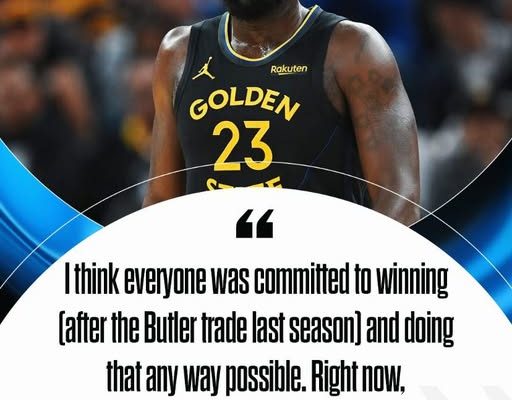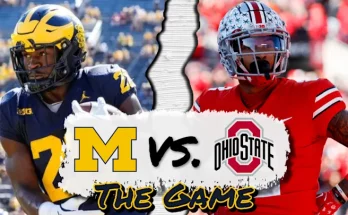Draymond Green didn’t hold back after the Golden State Warriors’ sluggish start to the season, speaking candidly about the team’s struggles and laying bare the frustrations that have been simmering beneath the surface. After a 24-point blowout loss to the Oklahoma City Thunder on Tuesday, Golden State now finds itself at an uncharacteristic 6-6, a record that has set off alarm bells in the Bay Area and raised questions about the team’s chemistry, consistency, and overall direction. For a team that has dominated the NBA landscape over the last decade, the slow start has been shocking, and Green’s forthright comments underscore the growing sense of urgency within the squad.
The Warriors have long been defined by their offensive firepower, unselfish ball movement, and defensive intensity. Yet, in the first dozen games of the 2025–26 season, none of these hallmark traits have been consistently visible. Tuesday’s loss to the Thunder highlighted a series of issues that have plagued Golden State: missed defensive rotations, poor shot selection, turnovers, and a lack of the cohesion that has historically propelled them to championships. Green, a player known as much for his leadership as for his intensity on both ends of the floor, didn’t mince words in addressing these shortcomings.
“You can’t be winning when we’re playing like this,” Green said postgame, his tone equal parts frustration and determination. “We’ve got guys out there not playing to their potential, and we’ve got to wake up. There’s no time for excuses.” His comments reflect the mindset of a veteran who knows what it takes to win at the highest level, and he’s sending a message to both his teammates and the wider basketball world: the Warriors aren’t satisfied with mediocrity, and they aren’t about to let a slow start define their season.
The loss to the Thunder wasn’t just a minor setback; it was a comprehensive collapse. Golden State struggled to maintain leads, failed to protect the rim, and allowed Oklahoma City to dominate both the paint and the perimeter. Statistically, the Warriors were outperformed in nearly every major category: shooting percentage, turnovers, rebounds, and assists. The Thunder’s young core exploited mismatches, attacked the basket relentlessly, and hit crucial shots from beyond the arc, exposing vulnerabilities that Green has repeatedly identified as areas needing attention. The result was a 24-point deficit by the final buzzer, a margin that reflected not only Oklahoma City’s effectiveness but also Golden State’s inefficiencies.
While the Warriors have experienced slow starts before, the combination of roster turnover, aging stars, and injuries has made this season particularly precarious. Draymond Green, now one of the most experienced players on the roster, has been forced into a larger leadership role, guiding younger teammates while holding the team accountable to the standards that have long defined the franchise. His forthrightness is emblematic of a player who refuses to sugarcoat reality. “We know what we’re capable of,” Green continued. “We’ve done it before. But right now, we’re not showing it on the court. That’s on us, all of us. We’ve got to pick it up.”
One of the key issues Green identified is a lack of consistency on both ends of the floor. Golden State’s defense, which has been a hallmark of the team during its championship runs, has been porous at times. Opponents have been able to score in transition, exploit pick-and-roll situations, and find open looks beyond the three-point line with alarming frequency. On the offensive end, the Warriors have struggled with rhythm and spacing, often settling for contested jumpers or forcing passes into traffic rather than utilizing their trademark ball movement to create high-percentage opportunities. This inconsistency has left fans and analysts scratching their heads, as the talent on the roster has rarely been in question.
Part of the problem may stem from the team’s evolving identity. The Warriors are balancing the presence of superstar scorers like Stephen Curry and Klay Thompson with younger, developing players who are still finding their roles. Integrating new players while maintaining the fast-paced, fluid system that has defined Golden State’s success is no small task. Green, as the emotional and strategic anchor of the team, has been tasked with bridging that gap. His outspoken nature, while occasionally drawing headlines for its intensity, serves a crucial purpose: it sets expectations and establishes accountability.
Tuesday’s defeat also sparked discussion about the Warriors’ offensive efficiency. Curry, a two-time MVP and the face of the franchise, had a decent scoring night but struggled with consistency from deep and faced persistent defensive pressure from the Thunder. Thompson, known for his sharpshooting, also failed to find a rhythm, leaving the team without the scoring burst necessary to mount a comeback. Beyond the stars, role players have yet to consistently contribute at the level expected, highlighting the growing pains of a team that is trying to blend veteran experience with youthful energy.
Draymond Green’s leadership has never been solely about scoring. His value has always extended to defense, playmaking, and the intangible aspects of motivating teammates. This season, those qualities are under particular scrutiny as the Warriors attempt to recalibrate their approach. His candidness serves as a wake-up call, pushing the team to confront uncomfortable truths rather than ignoring them. “We’ve got too many games ahead to be playing like this,” Green said. “We need everyone locked in, ready to do their job, ready to compete every possession. That’s the only way we turn this around.”
Golden State’s coaching staff, led by Steve Kerr, has acknowledged the slow start but remains confident in the team’s ability to recover. Kerr has emphasized the need for communication, disciplined defense, and patience as the roster gels. Yet, it’s clear that veteran voices like Green’s are vital to maintaining urgency. His perspective combines realism with a sense of purpose: the team knows it can be better, and the responsibility to improve lies squarely on their shoulders.
Another factor contributing to the Warriors’ struggles is their injury situation. While Golden State has largely avoided long-term absences for key players, minor injuries and lingering fatigue can disrupt rhythm and rotation. The cumulative effect of wear and tear, combined with a demanding schedule, has challenged the team’s consistency. Green himself has occasionally been limited due to minor ailments, yet he continues to play a central role, often logging significant minutes and setting the tone defensively. His ability to lead by example is as critical as his vocal criticisms.
Analysts have pointed out that early-season struggles aren’t unusual for championship-caliber teams, especially those undergoing transition. The Warriors’ current record, though concerning, does not necessarily define the trajectory of the season. What matters more is how the team responds to adversity—a trait Draymond Green has consistently demonstrated throughout his career. He has been at the center of multiple title runs, often providing the spark in key moments, whether through defensive plays, clutch passing, or motivational intensity. His experience gives him a unique perspective on navigating the ups and downs of an NBA season.
The Thunder, for their part, capitalized on Golden State’s lapses, demonstrating a level of execution and composure that has made them one of the league’s more surprising teams in recent years. Their ability to exploit the Warriors’ defensive rotations and force turnovers is indicative of a broader shift in the NBA: young, hungry teams are increasingly capable of challenging established powers. For Golden State, the loss serves as a reminder that no opponent can be underestimated and that preparation, focus, and accountability remain essential, regardless of the opponent.
In the wake of the defeat, Green’s comments were both a critique and a call to action. He recognized the need for accountability, emphasizing that improvement begins internally. “We’ve got to be honest with ourselves,” he said. “We’ve got to look in the mirror and accept that we’re not playing at the level we’re capable of. We’ve got the talent, we’ve got the experience, now we’ve got to put it together. That’s it. No excuses, no blaming, just do the work.” His words resonated not only within the locker room but also with fans, who have been eager for the team to recapture the intensity and cohesion that defined previous championship runs.
Golden State’s upcoming schedule provides opportunities to rebound. Key matchups against both conference rivals and lower-tier opponents will test the team’s ability to implement lessons from early struggles. Draymond Green’s role as a vocal leader will be critical in ensuring that adjustments are made swiftly and that the team maintains focus under pressure. His willingness to confront uncomfortable truths and demand accountability reflects a mentality that has historically been synonymous with championship culture.
Beyond the immediate implications for the standings, the Warriors’ early-season struggles raise broader questions about the team’s long-term trajectory. With a core of veterans approaching the latter stages of their careers, balancing the integration of younger talent with the need to compete at a high level is a delicate task. Draymond Green, Stephen Curry, and Klay Thompson collectively represent the backbone of the franchise, and their ability to elevate younger players while maintaining elite performance will likely determine the team’s success in the coming years.
Fans and media have scrutinized Green’s outspokenness throughout his career, sometimes framing it as controversial or abrasive. However, moments like the postgame comments following the Thunder loss illustrate a different side of his leadership: a commitment to truth, accountability, and team improvement. His candid approach serves as a reminder that elite teams are built not only on talent but also on communication, confrontation of weaknesses, and a relentless drive to improve.
The Warriors’ situation at 6-6 is far from catastrophic, but it does highlight the importance of urgency, consistency, and adaptability. Draymond Green’s willingness to call out problems, both big and small, is central to addressing these challenges. As the season progresses, the team’s response to early setbacks will reveal whether they can regain the cohesion and competitive edge that have been their hallmark.
Ultimately, the Warriors’ path forward is a test of character as much as skill. Tuesday’s 24-point loss to the Thunder was a wake-up call, but it is also an opportunity. Draymond Green, with his combination of leadership, intensity, and experience, is uniquely positioned to guide the team through this period of adjustment. His unfiltered assessment of the team’s struggles signals a desire not to settle for mediocrity but to pursue excellence relentlessly.
The season remains young, and the Warriors have ample time to recalibrate. However, the clock is ticking, and every game carries weight in a competitive Western Conference. Golden State’s ability to internalize lessons from losses, implement strategic adjustments, and maintain high standards will determine whether the early-season slump is a temporary hiccup or the start of a more prolonged challenge. In this context, Draymond Green’s voice becomes more than just criticism—it is a rallying cry, a declaration that the Warriors will not quietly accept underperformance, and a reminder that championship culture is rooted in accountability, effort, and resilience.
In the final analysis, the Warriors’ 6-6 record and recent blowout loss are not definitive judgments but rather catalysts for action. Draymond Green’s comments encapsulate the mindset required to navigate adversity: honesty, accountability, and an unyielding commitment to improvement. As Golden State continues its season, the question is not whether they have the talent to succeed—they clearly do—but whether they can unify, execute, and play up to their standards consistently. Green’s leadership ensures that complacency has no place in the locker room, setting the stage for a team determined to reclaim its identity and restore its dominance.
The Warriors’ journey this season will undoubtedly be closely watched, both by fans hoping for a return to championship form and by analysts assessing the resilience of one of the NBA’s most celebrated franchises. Draymond Green’s candid reflections following the loss to the Thunder serve as a microcosm of the challenges ahead: confronting weaknesses directly, motivating teammates, and refusing to settle for anything less than excellence. If the early-season struggles have taught the team anything, it is that greatness requires vigilance, consistency, and leadership at every level—a lesson Green has delivered with characteristic intensity and clarity.
As Golden State moves forward, the lessons from Tuesday’s loss and Green’s unfiltered assessment will likely shape not only the remainder of the season but also the culture of the team in years to come. For a franchise accustomed to success, early setbacks are never embraced—they are dissected, analyzed, and addressed with precision. Draymond Green’s voice ensures that the Warriors remain focused, accountable, and hungry, setting the tone for a season that still has the potential to be defined not by a slow start but by the resilience and determination to overcome it.



